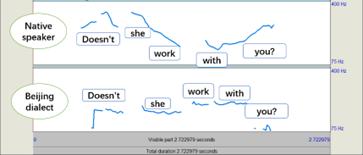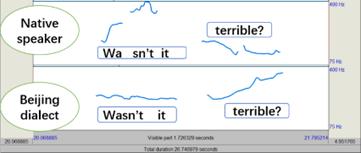1.Introduction
Many scholars have investigated the negative transfer of the pronunciation of English words in Beijing dialect. Negative transfer refers to the negative influence of the language rules of the mother tongue on a foreign language. Research on negative transfer can help learners and researchers better understand the obstacles in second language learning. However, most of the previous studies focused on words or syllables independent of context, while few scholars evaluated the impact of Beijing dialect on English sentences’ intonation with contexts [1,2,3].
It is important for college students to grasp how to use intonation in the proper context since it would be politer without misleading the listeners when college students are in academic exchange or at work. Meanwhile, for English teachers, understanding the intonation problems caused by Beijing dialect will help them to identify and understand students’ negative transfer in learning.
In this paper, under the influence of Beijing dialect, college students were asked to raise questions in three English interrogative contexts –finding out questions, making sure questions, and hoping for recognition of their own views.
The research was carried out using an APP called Praat to analyze students’ in Capital Normal University for their interrogative sentences’ intonation and nucleus in three different contexts and compared with native speakers. Alongside, a questionnaire was used to investigate college students' cognition of the importance of intonation learning, self-evaluation, review of learning methods and resistance to the learning process. Finally, two foreign teachers were interviewed to evaluate the intonation level of Beijing dialect students with improvement methods.
The intonation of interrogative sentences in Beijing dialect is mainly presented through the improvement and expansion of domain pitch, while in English it is mainly presented through pitch[4]. Besides, in Beijing dialect, syllables that are emphasized have a tendency to increase in pitch[5]. Because of the differences in language characteristics mentioned above, it was found that is possible to observe the negative transfer of subjects by comparing the intonation of interrogative sentences of Beijing dialect with those in English. This paper can provide a reference for scholars to study dialects and second language learning, especially for learners to explore the application of second language intonation in context.
2.Methodology of Intonation Test
2.1.Selection of Research Objects and Research Materials
The samples of eleven college students who had Beijing dialect from freshmen to the seniors in Capital Normal University were collected and compared with the native speaker audio in English Pronunciation in use written by Martin Hewings. Samples were involved in three different contexts, that is, finding out question, making sure question, and hoping for recognition with their point of view. In addition, the subjects were invited to conduct a conversation in Chinese in an equivalent context. The aim was to find out the negative transfer of Beijing dialect. Besides, a questionnaire survey was conducted among 100 students from the same range with the audio samples, aiming to find out the causes of the problems from the perspective of the subjects. Finally, two foreign teachers, who had been teaching in Beijing universities for 15 years and 2 years respectively, were interviewed. The two foreign teachers gave the importance of intonation learning from the perspective of native speakers and practice, while they also evaluated the intonation level of Beijing dialect students with improvement methods.
2.2.Methodology of Audio Analysis and Questionnaire Analysis
This study adopted comparative and experimental methods to compare native English speakers with samples of Advanced English learners in China by using the phonetic annotation method, so as to analyze sentence focus and reflect it through pitch and intonation.
2.2.1.Experimental Software
Praat, a language signal acquisition, analysis, and marking software, which plays an important role in the phonetic analysis of international second language learners, is mainly used for the analysis, annotation, processing and synthesis of digital speech signals, as well as generating a variety of language maps and text reports at the same time.
2.2.2.Selection and Collection of Corpus and Questionnaire
The study took audio samples of the subjects in a conversational manner. This is intended to let subjects judge the usage of intonation by themselves. In the process of questionnaire creation and collection, group members made self-judgment in the form of multiple-choice and degree scoring.
2.2.3.Analysis Process
Judge intonation and pitch of sentences through intonation curves, shown in figure 1-3, and compare with the sample of Beijing dialect in context.
2.3.Research Process
Data collection was divided into three steps: questionnaire data collection, audio data collection and interview data collection
2.3.1.Questionnaire Data Collection
The questions in the questionnaire were mainly used to investigate the importance of negative transfer of dialect, the learning methods in the past of those learners and the obstacles in learning. The function of the questionnaire was to collect negative transfer of learners in objective conditions and subjective factors. Then, it can be inferred that the intonation of interrogative sentences was influenced by Beijing dialect.
2.3.2.Audio Data Collection
Due to the impact of COVID-19 and the lockdown policy, only 11 subjects participated in the research. All of them are freshmen to seniors majoring in linguistics with Beijing dialect. At the same time, the choice of corpus relies on context, requiring subjects to judge the intonation required by the context. Based on the feedback of the questionnaire, it can be inferred by the inductive method that learners pay little attention to the combination of interrogative intonation and context thus three different interrogative contexts, finding out question, making sure question and hoping for recognition, are designed.
2.3.3.Interview Data Collection
The results of audio data pointed to the basic viewpoints of this essay. In order to further verify the experimental viewpoints, open interviews were used in this research. Meanwhile, through interviews with foreign teachers, the importance of intonation in the perspective of native English speakers and possible improvement plans are demonstrated.
2.4.Results and Analysis
The audio samples were compared to native speakers in three categories of context. A total of 11 audio samples were analyzed in this study. Due to the space limitation, the most representative sample of each context will be selected for analysis, while the rest cases will be presented in written form. Meanwhile, samples were analyzed in two aspects, pitch and intonation.
2.4.1.Finding Out Question: What Part of Spain Were You In?

Figure 1: Analysis of finding out question.
Pitch features: The native speaker used pitch to emphasize the focus of the sentence, rising in pitch in "what" with "part" as the emphasis and the highest pitch in the sentence. However, in the selected sample of Beijing dialect subjects, pitch is not emphasized at the focus of the sentence. It is worth noting that only 4/11 of all the samples had significant pitch improvement at the sentence intersection, while 5 of the other 7 showed a decline in intonation when reading the focus words when asking questions in Beijing dialect, which was also reflected in the English questions. Intonation features: When asking for information, native speakers adopted a falling tone, while the interviewees in the sample have no obvious fluctuation in intonation and tend to have a rising tone at the end. In all the samples, the proportion of standard intonation was 3/11, and the intonation ending of the other subjects' sentences was falling and rising. In contrast, only 3 out of 11 subjects had significant tone fluctuations. The intonation of those samples was similar to the subjects’ mother tongue, Beijing dialect, which uses modal particles at the end of the question coupled with a rising intonation. Among the 8 sentences with rising and falling intonation at the end of the English recording, 6 sentences ended in falling and rising intonation when the subjects asked questions in Beijing dialect, and all of them ended with a rising tone. The remaining two sentences of the 8 non-standard subjects showed irregular changes in intonation, which were consistent with the intonation of the questions in Beijing dialect, presumably influenced by the personal language habits of their mother tongue.
2.4.2.Making Sure Question: Doesn’t She Work with You?

Figure 2: Analysis of making sure question.
Pitch features: The subject did not consciously emphasize sentence focus by pitch, as compared to the native speaker. In all the samples, 5/11 subjects consciously made pitch differences in sentence focus, while only one of them completely matched the pitch of the native speaker sample. The other four subjects did not make pitch differences and two of them incorrectly emphasized the functional word “with”. Intonation features: The native speaker sample used falling and rising intonation at the focus of the sentence to verify the information. In making sure question, falling and rising intonation were used to emphasize the sentence focus. In contrast, the intonation of the Beijing dialect sample did not change significantly but suddenly fell in the use of "you" at the end of the sentence. Furthermore, only 4/11 of the subjects in Beijing dialect adopted falling and rising intonation. Three out of eleven respondents had no obvious change in intonation, and five out of eleven respondents had fallen intonation. He Yang and Liu Fang put forward that in Beijing dialect when modal particles like "ah" and "ba" are adopted to verify information. Most users express themselves in an extremely low tone[6]. Thus, it can be inferred that the subjects were influenced by Beijing dialect in making sure question.
2.4.3.Hoping for Recognition: Wasn’t It Terrible?

Figure 3: Analysis of hoping for recognition question.
Pitch features: In the native speaker sample, the word “it” had the highest pitch, while in the subject sample, the subject consciously raised the pitch at “it”, but still thought the last syllable of terrible was the highest pitch. Besides, in all the Beijing dialect subjects’ samples, only 2/11 subjects took “it” as the focus of the highest pitch, while the rest of the subjects showed the same situation as the sample is shown. Intonation features: The native speaker used a falling intonation to express the desire for recognition, while the subject used a rising intonation to express the desire for recognition. Furthermore, of all the subjects, 2/11 of them matched the intonation characteristics of native speakers, and the remaining 9 had rising intonation. In the Chinese version of the subjects' dialogue, the subjects mostly use a falling and rising intonation to express their hope for recognition with modal particles and the characteristics of intonation rising on modal particles were presented. For this reason, it can be inferred that Beijing dialect had an impact on English intonation learning.
3.Discussion
Through the analysis of the audio samples, it can be inferred that Beijing dialect has a certain influence on the intonation of English interrogative questions. In order to further explore the causes and consequences of such negative transfer, questionnaires and interviews were used in the study.
3.1.The Causes of Negative Transfer
The main reason contributing to negative transfer is that learners don’t pay enough attrition to intonation. Though they know the benefits of having good intonation, they put other elements into their priority. It is shown that 67% of the subjects didn’t think they need to pay attention to Beijing dialect on intonation learning.
Furthermore, only 2% of the learners choose to practice intonation with native speakers or their teachers, while others prefer to practice with videos or radios. However, from the perspective of interactionism, it is not an efficient way to learn [7,8]. Alongside, the biggest obstacle to improving intonation is the subject’s own psychological factor, that is, feeling shame to imitating a native speaker’s intonation (39%). According to the cognitivism view of learning, the output is an important factor in promoting language learning. Psychological shyness leads students to reduce output and practice, which is not conducive to improving intonation [9,10].
3.2.The Importance of Intonation and Possible Methods to Improve it
To find solutions, David Mo and Beverly Praner from Capital Normal University participated in the interview. They pointed out that improper intonation can cause confusion in communication. From the perspective of foreign teachers, visual learning such as Praat is more suitable for intermediate or advanced learners, while elementary learners need more interpersonal communication to improve intonation learning.
4.Conclusion
The research is aimed to identify the negative transfer of Beijing dialect to English interrogative intonation. By and large, influenced by Beijing dialect, subjects are inclined to use rising intonation in many situations unproperly. Furthermore, they did least well in making sure question with false recognition of the sentence focus. Though subjects have the conscious to emphasize the sentence focus with a higher pitch. Besides, the fluctuation of intonation of the eleven subjects is less obvious compared with the samples of a native speaker. After comparing the intonation characteristics of Beijing dialect, it can be inferred that it is influenced by the modal words of Beijing dialect and the low fluctuation of the intonation of Beijing dialect. The samples from subjects are limited to only 11 people. Unfortunately, since the lockdown policy during COVID-19, it was difficult to find more suitable subjects. Future researchers can explore the influence of dialects on English intonation learning by exploring gender, age of learners or stage of intonation learning.
References
[1]. Liu Meng. (2017). The influence of Beijing dialect of English word stress output (master's degree thesis, Hunan university). https://kns.cnki.net/KCMS/detail/detail.aspx?dbname=CMFD201802&filename=101802 0220.nh
[2]. Zhao Peng.(2012). A Study on English Monophonic Problems among College Students whose mother tongue is Beijing Dialect. Journal of Chinese Education and Teaching in Foreign Languages (03),32-35.
[3]. Guo, X. R., Chen, X. X., & Guo, Y. M. (2017, February). Perception of English Lexical Stress by English, Beijing Dialect, and Guangzhou Cantonese Speakers. In 2017 2nd International Conference on Humanities and Social Science (HSS 2017) (pp. 252-257). Atlantis Press.
[4]. Wang Ping & Shi Feng.(2010). Intonation fluctuation of Interrogative sentences in Chinese Beijing Dialect. Nankai Language Journal (02),14-22+185.
[5]. Sun Ying.(2010). The Stalling rate of focus Sentence intonation in Chinese Beijing Dialect. (eds.) Proceedings of the Ninth Chinese Phonetics Conference (pp.942-947).
[6]. He Yang & Liu Fang.(2016). The Function of Very Low intonation in Beijing Dialect -- Also on the Nature of Modal Words "ah" and "ba". Chinese Studies (03),10-15.
[7]. Mackey A. and J. Philp. 1998. 'Conversational interaction and second language development: Recasts, responses and red herrings.' Modern Language Journal 821 3: 338-56.
[8]. Mackey A. and S. M. Gass, and K. McDonough. 2000. 'How do learners perceive interactional feedback?' Studies in Second Language Acquisition 2214:471497.
[9]. Shen Qiongfang.(2021). The importance of Psychological Factors in College English Teaching. English for College (39),17-18.
[10]. Haidara, Y. (2016). Psychological Factor Affecting English Speaking Performance for the English Learners in Indonesia. Universal Journal of Educational Research, 4(7), 1501-1505.
Cite this article
Yu,X. (2023). A Study of Intonation of English Sentences of College Students Whose Mother Tongue is Beijing Dialect ——Taking Interrogative Sentences as Examples. Communications in Humanities Research,2,465-470.
Data availability
The datasets used and/or analyzed during the current study will be available from the authors upon reasonable request.
Disclaimer/Publisher's Note
The statements, opinions and data contained in all publications are solely those of the individual author(s) and contributor(s) and not of EWA Publishing and/or the editor(s). EWA Publishing and/or the editor(s) disclaim responsibility for any injury to people or property resulting from any ideas, methods, instructions or products referred to in the content.
About volume
Volume title: Proceedings of the 3rd International Conference on Educational Innovation and Philosophical Inquiries (ICEIPI 2022), Part III
© 2024 by the author(s). Licensee EWA Publishing, Oxford, UK. This article is an open access article distributed under the terms and
conditions of the Creative Commons Attribution (CC BY) license. Authors who
publish this series agree to the following terms:
1. Authors retain copyright and grant the series right of first publication with the work simultaneously licensed under a Creative Commons
Attribution License that allows others to share the work with an acknowledgment of the work's authorship and initial publication in this
series.
2. Authors are able to enter into separate, additional contractual arrangements for the non-exclusive distribution of the series's published
version of the work (e.g., post it to an institutional repository or publish it in a book), with an acknowledgment of its initial
publication in this series.
3. Authors are permitted and encouraged to post their work online (e.g., in institutional repositories or on their website) prior to and
during the submission process, as it can lead to productive exchanges, as well as earlier and greater citation of published work (See
Open access policy for details).
References
[1]. Liu Meng. (2017). The influence of Beijing dialect of English word stress output (master's degree thesis, Hunan university). https://kns.cnki.net/KCMS/detail/detail.aspx?dbname=CMFD201802&filename=101802 0220.nh
[2]. Zhao Peng.(2012). A Study on English Monophonic Problems among College Students whose mother tongue is Beijing Dialect. Journal of Chinese Education and Teaching in Foreign Languages (03),32-35.
[3]. Guo, X. R., Chen, X. X., & Guo, Y. M. (2017, February). Perception of English Lexical Stress by English, Beijing Dialect, and Guangzhou Cantonese Speakers. In 2017 2nd International Conference on Humanities and Social Science (HSS 2017) (pp. 252-257). Atlantis Press.
[4]. Wang Ping & Shi Feng.(2010). Intonation fluctuation of Interrogative sentences in Chinese Beijing Dialect. Nankai Language Journal (02),14-22+185.
[5]. Sun Ying.(2010). The Stalling rate of focus Sentence intonation in Chinese Beijing Dialect. (eds.) Proceedings of the Ninth Chinese Phonetics Conference (pp.942-947).
[6]. He Yang & Liu Fang.(2016). The Function of Very Low intonation in Beijing Dialect -- Also on the Nature of Modal Words "ah" and "ba". Chinese Studies (03),10-15.
[7]. Mackey A. and J. Philp. 1998. 'Conversational interaction and second language development: Recasts, responses and red herrings.' Modern Language Journal 821 3: 338-56.
[8]. Mackey A. and S. M. Gass, and K. McDonough. 2000. 'How do learners perceive interactional feedback?' Studies in Second Language Acquisition 2214:471497.
[9]. Shen Qiongfang.(2021). The importance of Psychological Factors in College English Teaching. English for College (39),17-18.
[10]. Haidara, Y. (2016). Psychological Factor Affecting English Speaking Performance for the English Learners in Indonesia. Universal Journal of Educational Research, 4(7), 1501-1505.









